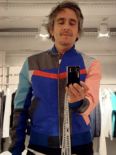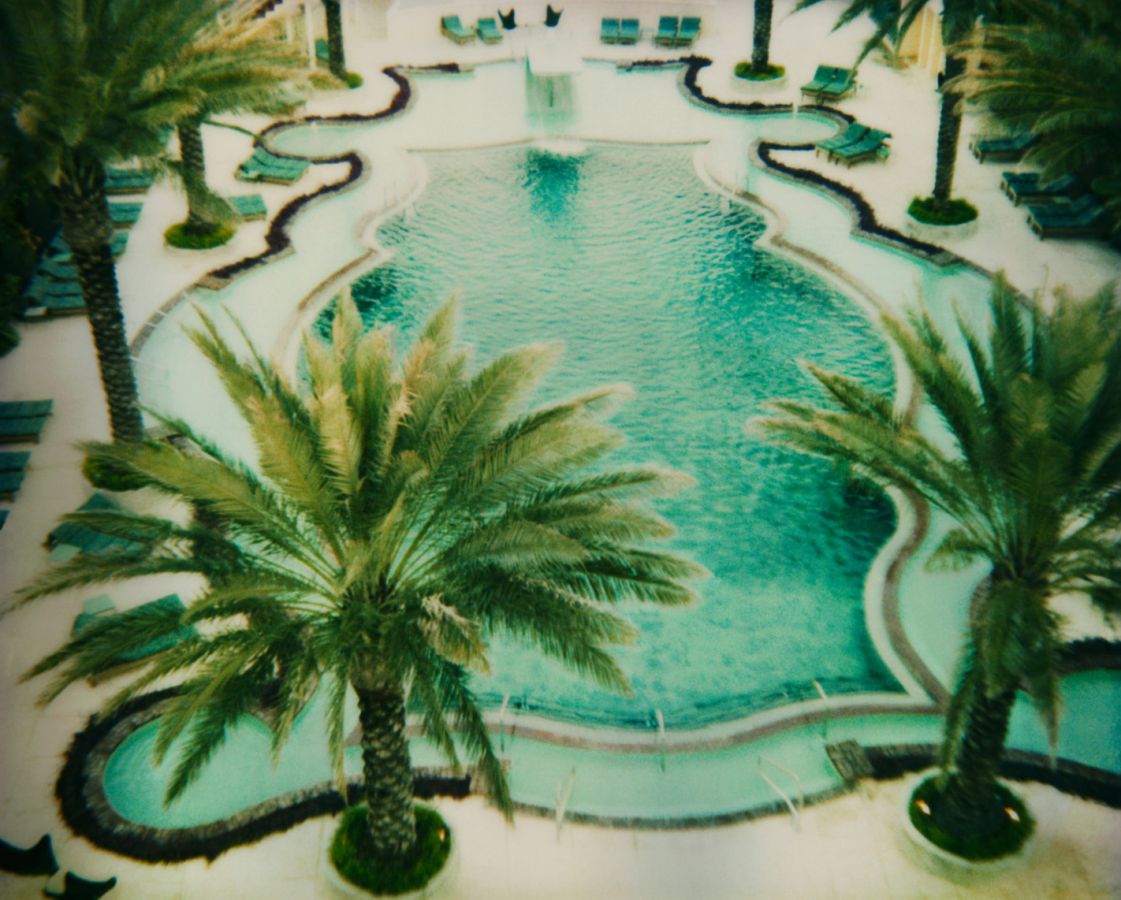About the artist

Mischievous, saturnine
Geoffroy de Boismenu has been feeding the fashion press for the past twenty years. In the 90s , he moved to New York and shot artists whose popularity, sometimes, begun to explode - Biggie was shot for Spin magazine before his first album was released, the Gravediggaz's first single , or Outkast and Mary J. Blige - he shot legends too, as Public Enemy or LL COOL J. He worked for labels and magazines, quickly incorporates hip-hop tour of the city and has created a nice personal photographic collection. He returned to France in 2000 and stored its records and archives in his country home in Britany. But one day, he returned there after two months spent elsewhere and found the flooded building : part of its records was destroyed but He managed to save a few boxes, providing them a unique look .
After spending eight years in the United States in the 90s, he returned to Paris and started developing personal projects. Libenter, the first of these, was a series of intimate and contemplative images shot around his parents’ house in the country, often with a blurred foreground reflecting the difficulty in departing from his child’s vision of a familiar environment. Geoffroy de Boismenu carries a camera at all times - a Nikon f2, Konica T4 or iPhone - and takes pictures every day; he occasionally returns to his collection of images and reassembles it, as in his latest book Image System which features new compositions based on snaps shot with a Polaroid Image System camera in 1993, during his US wanderings. Boismenu’s photography develops in line with his obsessions of the moment - what he himself calls his “collectionitis” – when he becomes equally infatuated with metal tridents or half-naked girls. His curiosity cabinet also features a blue tit, a rusty revolver and specks of dust, all arranged as a small set of almost innocent still lives.
Interview
What are your earliest memories of photography?
I think it was
when I was twelve; my father worked for Air France and had taken us to
Hong Kong, where I was born in fact. My parents had bought me my first
camera, a second-hand Konica, and there I was for two weeks, taking
pictures. It’s funny, I recently found some of these photos and they
almost look like images I could be shooting today. I took pictures of
rickshaw pullers, but as I did not want them to see me and strike poses,
I hid behind a wooden fence and shot through a small crack. This made
the images all black, with in the middle a slit and a blurred figure. I
realise that back then, I had an instinctive sense of composition which I
have tended to lose at times by wanting to work on it too much.
Did you do more exteriors than intimate family scenes?
Both.
I think one of the very first pictures I took – not surprisingly, it’s
totally in character for me, my clownish and at the same time
ultra-sentimental side – was of my mother sitting in my father’s lap.
And then there was also nature: we lived in the suburbs, and I remember
photographing bits of branches, pieces of leaves, a few flowers. Then
came adolescence, and I pretty much stopped altogether, or at least
wasn’t photographing is a psychotic manner as before.
How did you come back to photography?
After
high school, I pretended I was studying for a while, all sorts of
stuff, and then I became copywriter for a PR company, did a bit of art
direction, and finally in the late 1980s, I decided to go into fashion
photography. I wanted to do fashion with ordinary people as models, I
firmly believed in that. I started to canvass agencies with a series I
had shot in my parents’ village, portraits of local people on a white
backdrop, a bit like Avedon. Luckily, it worked out relatively quickly.
Basically, I wasn’t really interested in fashion itself: I just wanted
to move in those circles and do what I liked - and I just did things my
way.
So you had a career in advertising and fashion photography: when did you start working on personal projects?
I always took pictures between commissions, but I never thought of them as “personal projects”. When I did my book Libenter,
a project about my parents’ house, it was really the first time I had
set myself rules and picked my tools: one camera, a Hasselblad, and very
little depth of field. It was my first self-assigned commission, and I
loved it. I thought of it almost as a technical exercise in style – for
instance, I tried to find a way to transcribe the smell of a flower, or
of the soil at a particular time of day.
It was also an exercise in contemplation.
I’m
the contemplative type: I’m always the first to spot the beetle under a
leaf; I hear a little squeak and think hey, a shrew just broke a nail
on its third toe… I know the trees, the cries of birds. Hence the series
of rocks etc. I made. I enjoyed doing them, but in the current context,
which is so very conceptual, these things are unfortunately considered
too cutesy.
You shoot a little every day and you gather objects more or less compulsively: are you a collector?
My
projects often reflect a form of “collectionitis”, which is an attitude
that makes me amass things pretty frantically. Sometimes, I look at
them and try to put them together. For example, Boisemania - a
project where I show all the envelopes people have sent me with my name
misspelt - is not a collection as such, it’s just stuff that I keep,
that I can’t throw away. I don’t throw anything away. The eBay
project was also an expression of my collectionitis: for a while, I
bought dozens and dozens of bits of metalwork, particularly tridents,
and I thought I had to photograph this moment of madness.
My approach
is similar in these images: these still lives were not necessarily
composed with objects I have collected, but rather that I can’t get rid
of. I have jay feathers, a small blue tit, pebbles etc. and when I look
at them in detail, it’s all just so pretty.
Selected shows and awards
Constant Elevation, Art Ligue, Paris, 2015
France(s) territoire liquide, Tri Postal, Lille, 2014
Clinic, Hôpital Beaujon, Clichy, 2009
Clinic, Musée d’art moderne de Lyon et Griesmar & Tamer, Paris, 2008
f2, Kiosque, Paris, 2008
The conversation, Office 33, Hamburg, 2006
Les biches, Bound, Paris, 2006
The conversation, Colette, Paris, 2005
Libenter, Studio 58, Paris, 2004
Selected publications
Image System, RVB Books / Janvier, 2011
f2, Hong Kong Phat Publishers, 2008
Clinic, Images en manœuvres, 2007
Chiiilll…dren!, Nuke, 2006
The conversation, Damiani, 2005
Libenter, Janvier / 779, 2004

 Mischievous, saturnine Geoffroy de Boismenu has been feeding the fashion press for the past twenty years. In the 90s , he moved to New York and shot artists whose popularity, sometimes, begun to explode - Biggie was shot for Spin magazine before his first album was released, the Gravediggaz's first single , or Outkast and Mary J. Blige - he shot legends too, as Public Enemy or LL COOL J. He worked for labels and magazines, quickly incorporates hip-hop tour of the city and has created a nice personal photographic collection. He returned to France in 2000 and stored its records and archives in his country home in Britany. But one day, he returned there after two months spent elsewhere and found the flooded building : part of its records was destroyed but He managed to save a few boxes, providing them a unique look .
Mischievous, saturnine Geoffroy de Boismenu has been feeding the fashion press for the past twenty years. In the 90s , he moved to New York and shot artists whose popularity, sometimes, begun to explode - Biggie was shot for Spin magazine before his first album was released, the Gravediggaz's first single , or Outkast and Mary J. Blige - he shot legends too, as Public Enemy or LL COOL J. He worked for labels and magazines, quickly incorporates hip-hop tour of the city and has created a nice personal photographic collection. He returned to France in 2000 and stored its records and archives in his country home in Britany. But one day, he returned there after two months spent elsewhere and found the flooded building : part of its records was destroyed but He managed to save a few boxes, providing them a unique look .